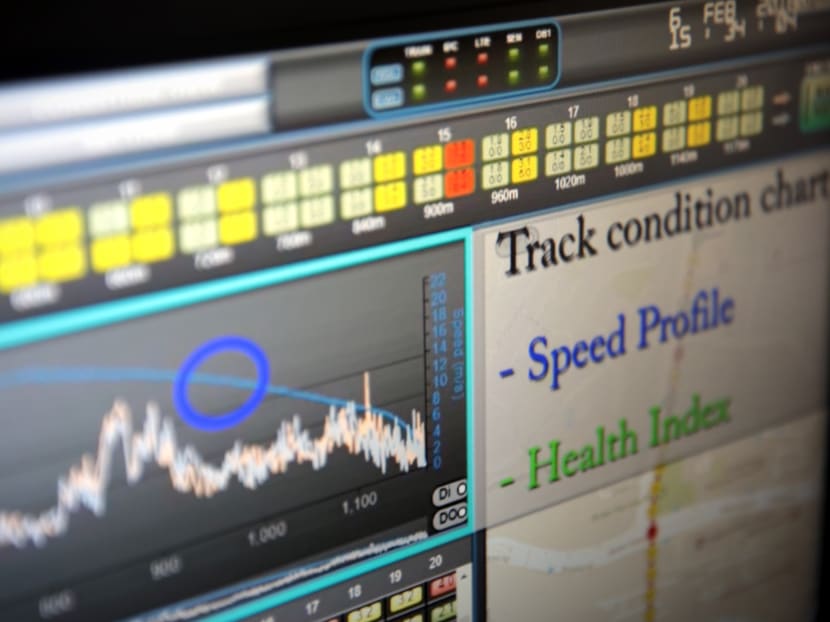SMRT taps predictive technology to prioritise maintenance
SINGAPORE — Commuters should expect fewer episodes of train or track faults as well as greater accuracy in estimating wait times for trains by the end of the year, as SMRT puts in place a series of new systems stemming from its investments in predictive technology.

A screen showing the interface of the Train and Track Condition Monitoring System seen during the SMRT technology media brief on March 16, 2018. Photo: Jason Quah/TODAY
SINGAPORE — Commuters should expect fewer episodes of train or track faults as well as greater accuracy in estimating wait times for trains by the end of the year, as SMRT puts in place a series of new systems stemming from its investments in predictive technology.
Outlining the initiatives that have been in the works for the past one to two years at a media briefing at the company’s Kim Chuan Depot on Friday (March 16), the rail operator’s chief executive officer Desmond Kuek said such tech adoption is to “attain and sustain better reliability, availability, maintainability, safety and security than today”.
One system SMRT is adopting, called the train and track monitoring system, has been in use by Hong Kong’s MTR Corporation for the past 10 years.
Unlike the existing system where the health of train tracks and running gears are monitored via a fixed schedule through manual inspection, the new system allows real-time monitoring while the trains are in operation, so that emerging track faults can be identified and maintenance work can be prioritised according to the risks detected.
The new system, developed with Hong Kong Polytechnic University, deploys one or two “scanner” trains — equipped with more sensitive fibre optic sensors — to check rail tracks for corrugation or cracks daily.
Sensors installed at City Hall MRT will also scan the entire North-South and East-West lines’ train fleet for defects such as wear and tear to the wheels or axel defects.
One of the engineers in the team working on the monitoring system, Mr Dennis Li, 27, said the new system allows his team to “detect and predict any anomalies or impending failures before it occurs”.
Mr Kuek added that Mr Li’s team will also explore the use of artificial intelligence (AI) to “automatically sift through track inspection image data for enhanced productivity”.
Another system, which will be in use by year-end, will allow SMRT to tap on multiple streams of data from all of its assets to predict the need for maintenance activities. It will replace the current schedule-based maintenance performed half-yearly, quarterly or yearly.
“The aim is to be able to predict and prevent failure, and should a fault occur, to respond and recover swiftly so that impact to commuters is minimised,” said Mr Kuek.
To give SMRT “better control of our maintenance activities”, Mr Kuek said a new system utilising AI will be in place by June, which will automate track access allocation for engineers to carry on maintenance work without a conflict in schedules. It will cut the current 10 steps required for track access to six, and reduce manual processes by half.
Harnessing such technologies to improve its operations are the focuses of the company’s Future Systems Office that was formed last year.
Apart from improving engineering systems, Mr Kuek also said SMRT is tapping on industrial internet-of-things to provide commuters with more accurate journey-time estimation at busy interchange stations by end of the year.
A new crowd sensing system, tapping on Wifi signals sent by commuters’ mobile devices, combined with data obtained from fare gates and train load, will allow SMRT to bring its estimates for wait time accuracy to about 80 to 90 per cent.
The estimates will be available on the revamped SMRTConnect app.
Without revealing how much SMRT is spending on implementing such technology, its chief technology officer Ng Bor Kiat said the company spares “no effort” in investing resources, whether in terms of engineering manpower or money or time.
“So long as we evaluate and assess a certain technology to be of importance towards delivering reliable service systems and creating a positive commuter experience, we would take a decision to invest,” he said.
He added that the company started to expand the use of technology to transform its rail network some five to six years ago. Since then, close to 70 per cent of work in deploying condition monitoring systems are either operational or are works in progress.
In a fact sheet, SMRT stated that the remaining one third of projects planned include the building of a platform screen door monitoring system, signal power monitoring system, and ground penetrating radar system.








